Crayke
OS grid reference:-
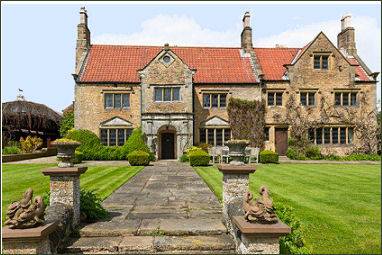
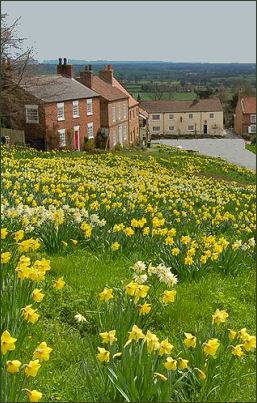 The pretty and peaceful village of Crayke, in the lovely Howardian Hills, an Area of Ooutstanding Natural Beauty, is situated around two miles to the east of Easingwold and around 3 miles to the south of the village of Oulston.
The pretty and peaceful village of Crayke, in the lovely Howardian Hills, an Area of Ooutstanding Natural Beauty, is situated around two miles to the east of Easingwold and around 3 miles to the south of the village of Oulston.
Crayke stands at an elevation of 368 feet (112 metres) on the southern slopes of the steep Castle Hill and is located on a mediaeval road from York to the north by way of Coxwold and Thirsk and just to the north of the great medieval forest of Galtres. Its name derives from the old Brythonic Celtic word crec, meaning crag.
The village is steeped in history, there is evidence to suggest that a settlement existed at Crayke as far back as Anglo-Saxon times. Ecgfrith, (circa 645 – 685) the seventh-century king of the tribal kingdom of Northumbria, granted the village to the church in 685 to be used by his advisor St. Cuthbert, Bishop of Lindisfarne, on his visits to York, Cuthbert founded a monastery at Crayke.
Crayke was home to Echa of Crayke, an eighth century Anglo-Saxon Saint, priest and monk-hermit, known for his holliness, healing and prophetic gifting. The York Annals record he died 767AD, and his feast day was held on 5 May. He is known from the Hagiography of the Secgan Manuscript, and the poem on the Saints of York by Saint Alcuin. The Anglo-Saxon monk Aediluulf wrote a Latin poem 'Carmen de Abbatibus' between 803 and 82, covering the history of his monastery, it has been suggested that the monastery, which was in the circle of Lindisfarne, was in Crayke. Other records state that Echa was ordained a priest, and spent most of his life as a hermit. Whether he was attached to a monastic community at Crayke, or whether he only settled with the monks at Crayke when his health deteriorated, remains unknown.
According to the chronicler Symeon, the Northumbrian King Aelle appropriated Crayke to use as his headquarters during the unsuccessful campaign against the Viking invaders in 867. He also reports that when the congregation of St Cuthbert was wandering homeless during the seven-year period 875-882 the monks remained four months at Crayke.
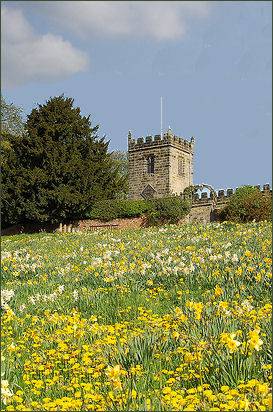 Crayke is mentioned in the Domesday Survey of 1086 where it is referred to as Crec and belonged
to the Bishop of Durham. In Norman times the Bishops of Durham built a castle over the monastic cemetery, though no traces are now remain of the building.
Links with Cuthbert and the bishopric of Durham are recognised in the dedication of the 1436 Anglican church to St Cuthbert, and in the name of the village pub as the Durham Ox, an allusion to the foundation myth of Durham.
Crayke is mentioned in the Domesday Survey of 1086 where it is referred to as Crec and belonged
to the Bishop of Durham. In Norman times the Bishops of Durham built a castle over the monastic cemetery, though no traces are now remain of the building.
Links with Cuthbert and the bishopric of Durham are recognised in the dedication of the 1436 Anglican church to St Cuthbert, and in the name of the village pub as the Durham Ox, an allusion to the foundation myth of Durham.
The village church (pictured left) is dedicated to St Cuthbert. It was so named after the time of the Viking invasions, when the body of St Cuthbert was unearthed and travelled around the north of England to protect it. The monks rested with his body at Crayke for a while.
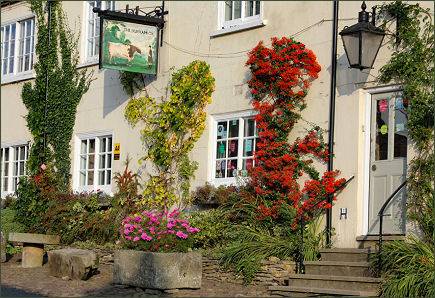 The present building was erected in 1490 and is in the Perpendicular style. The church is constructed in ashlar stone. The east window has three lights, and contains stained glass by William Wailes. The font dates from the fifteenth century, and the pulpit is dated 1637. The pews date from the seventeenth century. In the church is a late sixteenth century memorial with recumbent stone effigies.
The present building was erected in 1490 and is in the Perpendicular style. The church is constructed in ashlar stone. The east window has three lights, and contains stained glass by William Wailes. The font dates from the fifteenth century, and the pulpit is dated 1637. The pews date from the seventeenth century. In the church is a late sixteenth century memorial with recumbent stone effigies.
The village inn, the Durham Ox, (pictured right) dates back at least three hundred years and is an award winning traditional pub complete with flag stone floors, exposed beams, oak panelling and roaring fires in winter. The pub offers delicious meals made of locally sourced produce and offers accommodation..
The village is designated as a conservation area, especially the churchyard, which has 24 varieties of wild flowers, some of which are very rare species. The vilalge green is particularly attractive in the spring when it is awash with daffodils. Stone cottages are positioned irregularly along either side of the main street, which forks some distance below the church. Half a mile below the village, on the Brandsby road, stands Wyndham Hall, now known as Crayke Manor (pictured above right). To celebrate the Millennium, a trail has been laid around the village, with mosaic markers, which portray different aspects of the surrounding countryside.
The nearby Dutch house wildlife garden in is an ecological and sustainable garden focussed on attracting wildlife. The garden contains a collection of native trees, herbaceous borders, a wild flower meadow, kid's nature zone and a display of sculptures.
Crayke Castle
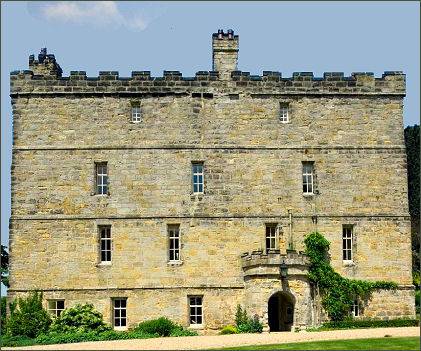 Crayke Castle sits proudly on Church Hill in the village of Crayke. A a grade I listed building, it dates to the fifteenth century and consists of a restored four storey tower house with attached outbuildings to the rear and a separate ruined fifteenth tower, the "New Tower". The castle is situated on the highest point in the Parish at an elevation of 379 feet.
Crayke Castle sits proudly on Church Hill in the village of Crayke. A a grade I listed building, it dates to the fifteenth century and consists of a restored four storey tower house with attached outbuildings to the rear and a separate ruined fifteenth tower, the "New Tower". The castle is situated on the highest point in the Parish at an elevation of 379 feet.
Evidence exists that a castle was constructed on the existing site soon after the Norman Conquest. The building is attributed to Bishop Hugh Pudsey.
The present building was constructed around 1450 for Robert Neville, Bishop of Durham on land which had belonged to the See of Durham since Saxon times.
Up until the reign of James I (1603-25) the castle was surrounded by a deer park. During the Civil War the castle was slighted by the Parliamentarians and sold in 1648 to Sir William Allanson, a former Mayor and MP of York. Allanson's son Charles repaired and restored the main building.
In about 1667 the manor was restored to the See of Durham to be leased out as a farmhouse until Bishop William van Mildert was allowed by Parliament to sell it into private hands in 1827.
Historic Buildings of Yorkshire
